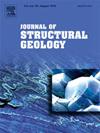Deformation mechanisms of compressional overlapping area in strike-slip fault zone: Insights from experimental simulation
IF 2.9
2区 地球科学
Q2 GEOSCIENCES, MULTIDISCIPLINARY
引用次数: 0
Abstract
As an intense deformation region, the compressional overlapping areas of strike-slip faults play a crucial and significant role in influencing fault propagation, seismic activity, and the formation and distribution of hydrocarbon reservoirs. Hence, enhancing the comprehension of detailed microscopic deformation mechanisms lays the foundation for a better understanding of the macroscopic deformation, constituting the core issue of this study. Compressional en échelon fault model experiments were conducted, combining with acoustical and optical measurements to simulate fault interactions and mechanical coupling within fault systems. The experimental results manifest that three distinct episodes of derived faults were observed during the interaction of pre-existing faults. Firstly, a group of derived faults extends from the ends of the overlapping area, conjugating with the pre-existing en échelon faults. Secondly, the fault consisting of a series of secondary fractures propagates from the ends of the overlapping area towards the interior, leading to a complete destruction of the overlapping area. Thirdly, another group of faults extends from the ends of the overlapping area, forming a rhombic region in conjunction with the two pre-existing faults. Furthermore, the analysis of the strike-slip rate distribution along two en échelon faults showed significant heterogeneity. Specifically, the segments with relatively low strike-slip rate were inferred to be locked zones, which are likely to act as nucleation points for future emergent deformation events. These simulation results contributed to understanding the issues such as the mechanical coupling between Garlock and San Andreas fault systems, the linkage fault development in the branching zones of the North Anatolian Fault Zone, and the kinematic intersection geometry between the Danghenan Shan and Altyn Tagh faults.
走滑断裂带挤压叠加区的变形机制:实验模拟的启示
走滑断层挤压叠合区作为一个强烈的变形区,对断层扩展、地震活动以及油气藏的形成和分布有着至关重要的影响。因此,加强对细观变形机理的理解,为更好地理解宏观变形奠定基础,是本研究的核心问题。结合声学和光学测量,进行了压缩en - cheon断层模型实验,模拟了断层相互作用和断层系统内的力学耦合。实验结果表明,在原有断层的相互作用过程中,观察到三次不同的派生断层。首先,一组衍生断层从重叠区域的末端延伸出来,与已有的en - samchelon断层相结合。其次,由一系列次生裂缝组成的断层从叠置区末端向内部扩展,导致叠置区完全破坏。第三,另一组断裂从叠置区末端向外延伸,与原有的两条断裂形成菱形区域。此外,沿两个en - samacheon断层的走滑速率分布分析显示出明显的非均匀性。具体而言,走滑速率相对较低的段被推断为锁定带,可能成为未来紧急变形事件的成核点。这些模拟结果有助于理解Garlock和San Andreas断裂系统之间的力学耦合、北安那托利亚断裂带分支带的联动断裂发育以及砀河南山和阿尔金塔格断裂之间的运动学相交几何等问题。
本文章由计算机程序翻译,如有差异,请以英文原文为准。
求助全文
约1分钟内获得全文
求助全文
来源期刊

Journal of Structural Geology
地学-地球科学综合
CiteScore
6.00
自引率
19.40%
发文量
192
审稿时长
15.7 weeks
期刊介绍:
The Journal of Structural Geology publishes process-oriented investigations about structural geology using appropriate combinations of analog and digital field data, seismic reflection data, satellite-derived data, geometric analysis, kinematic analysis, laboratory experiments, computer visualizations, and analogue or numerical modelling on all scales. Contributions are encouraged to draw perspectives from rheology, rock mechanics, geophysics,metamorphism, sedimentology, petroleum geology, economic geology, geodynamics, planetary geology, tectonics and neotectonics to provide a more powerful understanding of deformation processes and systems. Given the visual nature of the discipline, supplementary materials that portray the data and analysis in 3-D or quasi 3-D manners, including the use of videos, and/or graphical abstracts can significantly strengthen the impact of contributions.
 求助内容:
求助内容: 应助结果提醒方式:
应助结果提醒方式:


